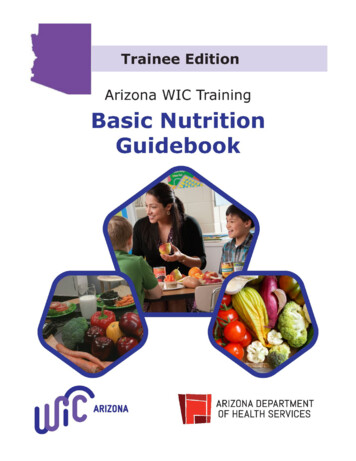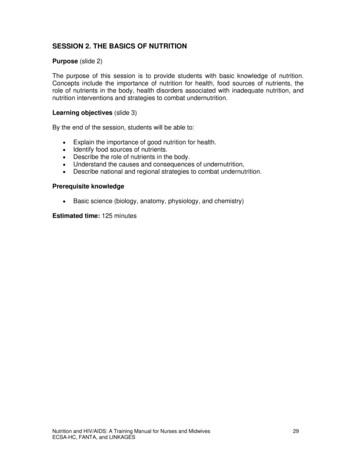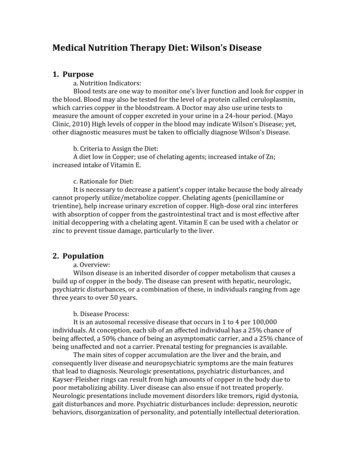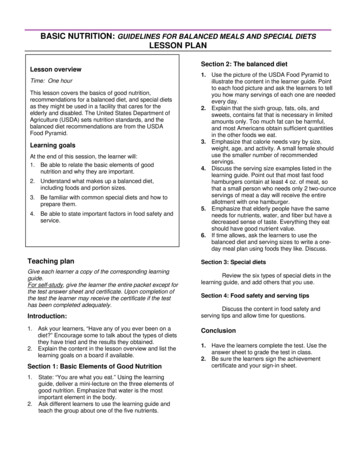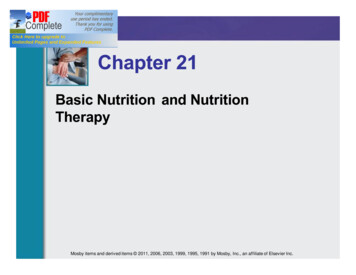
Transcription
Chapter 21Basic Nutrition and NutritionTherapyMosby items and derived items 2011, 2006, 2003, 1999, 1995, 1991 by Mosby, Inc., an affiliate of Elsevier Inc.
Basic Nutrition and NutritionalTherapy Nutrition is the total of all processes involved in thetaking in and utilization of food substances forproper growth, functioning, and maintenance ofhealth. Nutrition plays a role directly or indirectly in all bodyprocesses.Mosby items and derived items 2011, 2006, 2003, 1999, 1995, 1991 by Mosby, Inc., an affiliate of Elsevier Inc.Slide 2
Role of the Nurse in PromotingNutrition The nurse can promote good nutrition by§§§§§§§Helping the patient understand the importance of thediet and encouraging dietary complianceServing meal trays to patients in a prompt and positivemannerAssisting some patients with the eating processTaking and recording patient weightRecording patient intakeObserving clinical signs of poor nutrition and reportingthemServing as a communication linkMosby items and derived items 2011, 2006, 2003, 1999, 1995, 1991 by Mosby, Inc., an affiliate of Elsevier Inc.Slide 3
Basic Nutrition Diet Planning Guides§MyPyramid Bread, cereal, rice, and pasta groupVegetable groupFruit groupMilk, yogurt, and cheese groupMeat, poultry, fish, dried beans, eggs, and nuts groupFats, oils, and sweetsMosby items and derived items 2011, 2006, 2003, 1999, 1995, 1991 by Mosby, Inc., an affiliate of Elsevier Inc.Slide 4
Figure 21-1(From US Department of Agriculture, Washington, DC, 2005, US Government Printing Office.)MyPyramid, a personalized guide to daily food choices and numberof servings.Mosby items and derived items 2011, 2006, 2003, 1999, 1995, 1991 by Mosby, Inc., an affiliate of Elsevier Inc.Slide 5
Basic Nutrition Diet Planning Guides (continued)§MyPyramid (continued) Symbolizes a personalized approach to healthy eatingand physical activity Emphasizes key concepts regarding activity and lityMosby items and derived items 2011, 2006, 2003, 1999, 1995, 1991 by Mosby, Inc., an affiliate of Elsevier Inc.Slide 6
Portion size:Mosby items and derived items 2011, 2006, 2003, 1999, 1995, 1991 by Mosby, Inc., an affiliate of Elsevier Inc.Slide 7
Basic Nutrition Diet Planning Guides (continued)§Dietary Guidelines f or Americans These guidelines form the foundation of U.S. federalnutrition policy and directly affect federal nutritionprograms such as food stamps, school breakfast andlunch programs, and the Special SupplementalProgram for Women, Infants, and Children (WIC). These guidelines have been developed to address theimportance of adequate nutrition, as well as theprevention of overnutrition and disease.Mosby items and derived items 2011, 2006, 2003, 1999, 1995, 1991 by Mosby, Inc., an affiliate of Elsevier Inc.Slide 8
Basic Nutrition Diet Planning Guides (continued)§Dietary Ref erence Intakes (DRIs) This is a set of nutrient-based values that can be usedfor both assessing and planning diets. They form the basis for daily values used in theNutrition Facts labels on foods. The DRIs are intended to help individuals optimize theirhealth, prevent disease, and avoid consuming too muchof a nutrient.Mosby items and derived items 2011, 2006, 2003, 1999, 1995, 1991 by Mosby, Inc., an affiliate of Elsevier Inc.Slide 9
Basic Nutrition Essential Nutrients§Basic Functions Essential nutrients are those that our bodies cannotmake in amounts necessary for good health. The six classes of essential nutrients arecarbohydrates, fats, proteins, vitamins, minerals, andwater.Mosby items and derived items 2011, 2006, 2003, 1999, 1995, 1991 by Mosby, Inc., an affiliate of Elsevier Inc.Slide 10
Basic Nutrition Essential Nutrients (continued)§Basic functions Provide energy§§Carbohydrates and proteins: 4 kcal/gFat: 9 kcal/g Build and repair tissue§Protein, calcium, phosphorus, iron, and fat Regulate body processes§Metabolism: the combination of all chemical processesthat take place in living organismsMosby items and derived items 2011, 2006, 2003, 1999, 1995, 1991 by Mosby, Inc., an affiliate of Elsevier Inc.Slide 11
Basic Nutrition Essential Nutrients (continued)§Carbohydrates Main function of carbohydrates is to provide energy. Simple carbohydrates§§Simple sugars: monosaccharides and disaccharidesFound naturally in many nutritious foods such as milk andfruit Complex carbohydrates§§PolysaccharidesStarch, glycogen, and dietary fiberMosby items and derived items 2011, 2006, 2003, 1999, 1995, 1991 by Mosby, Inc., an affiliate of Elsevier Inc.Slide 12
Basic Nutrition Essential Nutrients (continued)§Carbohydrates (continued) Digestion and metabolism of carbohydrates§§§All carbohydrates except fiber are broken down in thedigestive tract into monosaccharides (simple sugar units).They then are absorbed and eventually converted toglucose.Glucose circulates in the bloodstream and is used by thecells for energy.Mosby items and derived items 2011, 2006, 2003, 1999, 1995, 1991 by Mosby, Inc., an affiliate of Elsevier Inc.Slide 13
Basic Nutrition Essential Nutrients (continued)§Carbohydrates (continued) Digestion and metabolism of carbohydrate§§If energy needs are met, carbohydrates will be stored asglycogen.Once glycogen stores are full, further excesses ofcarbohydrates will be converted to fat and stored asadipose tissue.Mosby items and derived items 2011, 2006, 2003, 1999, 1995, 1991 by Mosby, Inc., an affiliate of Elsevier Inc.Slide 14
Mosby items and derived items 2011, 2006, 2003, 1999, 1995, 1991 by Mosby, Inc., an affiliate of Elsevier Inc.Slide 15
Mosby items and derived items 2011, 2006, 2003, 1999, 1995, 1991 by Mosby, Inc., an affiliate of Elsevier Inc.Slide 16
Basic Nutrition Essential Nutrients (continued)§Fats (lipids) These are a group of organic substances of a fattynature that are insoluble in water and that arenecessary in the body for good health. Both fats and cholesterol are lipids. Adipose tissue is the body’s storage form of fat; it helpsinsulate the body from temperature extremes andserves as a cushion to protect organs and other tissues. Fat provides satiety; it adds flavor and aroma to foods.Mosby items and derived items 2011, 2006, 2003, 1999, 1995, 1991 by Mosby, Inc., an affiliate of Elsevier Inc.Slide 17
Basic Nutrition Essential Nutrients (continued)§Fats (lipids) (continued) Saturated fatty acids§§§Chemical bonds are completely filled or saturated withhydrogen.These are generally of animal origin and solid at roomtemperature.They increase blood cholesterol levels and the risk ofatherosclerosis.Mosby items and derived items 2011, 2006, 2003, 1999, 1995, 1991 by Mosby, Inc., an affiliate of Elsevier Inc.Slide 18
Mosby items and derived items 2011, 2006, 2003, 1999, 1995, 1991 by Mosby, Inc., an affiliate of Elsevier Inc.Slide 19
Basic Nutrition Essential Nutrients (continued)§Fats (lipids) (continued) Unsaturated fatty acids§§§§There is one or more places on its chemical chain wherehydrogen is missing.They can be monounsaturated or polyunsaturated.They usually have plant sources and are liquid at roomtemperature.They are thought to have a blood cholesterol-loweringeffect at moderate levels of intake.Mosby items and derived items 2011, 2006, 2003, 1999, 1995, 1991 by Mosby, Inc., an affiliate of Elsevier Inc.Slide 20
Basic Nutrition Essential Nutrients (continued)§Fats (lipids) (continued) Trans-fatty acids§§§§These are unsaturated fatty acids that vary slightly intheir chemical configuration from naturally occurringunsaturated fatty acids.They are produced during hydrogenation.They are found in foods containing partially hydrogenatedvegetable oils.They tend to increase blood cholesterol levels, but not asmuch as saturated fats.Mosby items and derived items 2011, 2006, 2003, 1999, 1995, 1991 by Mosby, Inc., an affiliate of Elsevier Inc.Slide 21
Basic Nutrition Essential Nutrients (continued)§Fats (lipids) (continued) Cholesterol§§§§It performs specific functions in the body but provides noenergy.It is synthesized in the liver and is found in foods ofanimal origin.Dietary cholesterol is highest in organ meats and eggyolks.Intake of dietary cholesterol should average no more than300 mg per day.Mosby items and derived items 2011, 2006, 2003, 1999, 1995, 1991 by Mosby, Inc., an affiliate of Elsevier Inc.Slide 22
Basic Nutrition Essential Nutrients (continued)§Fats (lipids) (continued) Digestion and metabolism of fats§§§§Fats must be emulsified by bile to be digested.Once emulsified, fats can be broken down and absorbed.Excess dietary fat will be stored as adipose tissue.Lipoproteins facilitate the transport of lipids in thebloodstream: high-density (HDL) and low-density (LDL)lipoproteins.Mosby items and derived items 2011, 2006, 2003, 1999, 1995, 1991 by Mosby, Inc., an affiliate of Elsevier Inc.Slide 23
Basic Nutrition Essential Nutrients (continued)§Protein Protein makes up the bulk of the body’s lean tissuesand organs. It is necessary for tissue growth and repair and woundhealing. Protein is made of smaller units called amino acids. There are 22 amino acids, but only nine of them areconsidered essential amino acids. The nine essential amino acids must be obtained fromthe diet.Mosby items and derived items 2011, 2006, 2003, 1999, 1995, 1991 by Mosby, Inc., an affiliate of Elsevier Inc.Slide 24
Basic Nutrition Essential Nutrients (continued)§Protein (continued) Complete proteins§§One that contains all nine essential amino acids insufficient quantity and ratio for the body’s needsGenerally of animal origin; found in foods such as meat,poultry, fish, milk, cheese, and eggs Incomplete proteins§§Lacking in one or more or the essential amino acidsPlant origin; include grains, legumes, nuts, and seedsMosby items and derived items 2011, 2006, 2003, 1999, 1995, 1991 by Mosby, Inc., an affiliate of Elsevier Inc.Slide 25
Basic Nutrition Essential Nutrients (continued)§Protein (continued) Vegetarian diets§§§§They are made up of mainly plant foods; some mayinclude dairy products or eggs as well.Lactovegetarian diet includes fruits, vegetables, grains,and milk and dairy products.Lacto-ovo-vegetarian diet also includes eggs.Protein needs can be met with a vegetarian diet; a widevariety of plant foods must be included.Mosby items and derived items 2011, 2006, 2003, 1999, 1995, 1991 by Mosby, Inc., an affiliate of Elsevier Inc.Slide 26
Basic Nutrition Essential Nutrients (continued)§Protein (continued) Protein-kilocalorie malnutrition§§§Individuals suffering from a lack of kilocalories or protein;body breaks down its own protein stores for energyKwashiorkor: Malnutrition caused by severe proteindeficiency; may occur in the presence of adequatekilocaloriesMarasmus: Condition of extreme malnutrition andemaciation due to inadequate kilocalories and proteinMosby items and derived items 2011, 2006, 2003, 1999, 1995, 1991 by Mosby, Inc., an affiliate of Elsevier Inc.Slide 27
Mosby items and derived items 2011, 2006, 2003, 1999, 1995, 1991 by Mosby, Inc., an affiliate of Elsevier Inc.Slide 28
Mosby items and derived items 2011, 2006, 2003, 1999, 1995, 1991 by Mosby, Inc., an affiliate of Elsevier Inc.Slide 29
Catabolism the body loses more nitrogen than it isconsuming. Negative nitrogen balance. Anabolism the amount of nitrogen consumed isgreater than the amount excreted. Positive nitrogenbalance.Mosby items and derived items 2011, 2006, 2003, 1999, 1995, 1991 by Mosby, Inc., an affiliate of Elsevier Inc.Slide 30
Basic Nutrition Essential Nutrients (continued)§Vitamins and minerals They are needed in small amount s; toxicity may occurwith overconsumption. They are best received from a balanced, varied diet. Vitamins can be destroyed by heat, light, and exposureto air. Minerals cannot be destroyed because they are singleelements rather than compounds. Both vitamins and minerals can be lost when foods arecooked in water.Mosby items and derived items 2011, 2006, 2003, 1999, 1995, 1991 by Mosby, Inc., an affiliate of Elsevier Inc.Slide 31
Basic Nutrition Essential Nutrients (continued)§Vitamins and minerals (continued) Vitamins§§Fat solubleo A, D, E, and Ko Usually carried in the fatty portion of foodo Can be stored by the bodyWater solubleo B vitamins and Co Not stored in the body; excesses excreted in theurineMosby items and derived items 2011, 2006, 2003, 1999, 1995, 1991 by Mosby, Inc., an affiliate of Elsevier Inc.Slide 32
Basic Nutrition Essential Nutrients (continued)§Vitamins and minerals (continued) Vitamins (continued)§Antioxidant vitaminso Vitamins E and C; previtamin form of A(beta-carotene)o Possible link to reduced risks of certain cancers andheart diseaseo Function by delaying or preventing the destruction orbreakdown of cell membranes in the presence ofoxygenMosby items and derived items 2011, 2006, 2003, 1999, 1995, 1991 by Mosby, Inc., an affiliate of Elsevier Inc.Slide 33
Basic Nutrition Essential Nutrients (continued)§Vitamins and minerals (continued) Vitamins (continued)§§Vitamin Co Adequate amounts are necessary for proper immunefunction.Vitamin Do Most common dietary sources include fortified milkand milk products.o The body can also make vitamin D from exposure tosunlight.Mosby items and derived items 2011, 2006, 2003, 1999, 1995, 1991 by Mosby, Inc., an affiliate of Elsevier Inc.Slide 34
Basic Nutrition Essential Nutrients (continued)§Vitamins and minerals (continued) Vitamins (continued)§§Vitamin Ko It plays a role in blood clotting.o A large fluctuation in vitamin K intake may alter theeffects of anticoagulation drugs.Folate (folic acid)o Before and during pregnancy, it may play a role inreducing the risk of neural tube defects in the infant.Mosby items and derived items 2011, 2006, 2003, 1999, 1995, 1991 by Mosby, Inc., an affiliate of Elsevier Inc.Slide 35
Mosby items and derived items 2011, 2006, 2003, 1999, 1995, 1991 by Mosby, Inc., an affiliate of Elsevier Inc.Slide 36
Basic Nutrition Essential Nutrients (continued)§Vitamins and minerals (continued) Vitamins (continued)§Vitamin B12o It is primarily found in foods of animal origin.o It requires a special intrinsic factor produced in thestomach for absorption.o Pernicious anemia may result with inadequateamounts of intrinsic factor because B12 is notabsorbed.Mosby items and derived items 2011, 2006, 2003, 1999, 1995, 1991 by Mosby, Inc., an affiliate of Elsevier Inc.Slide 37
Basic Nutrition Essential Nutrients (continued)§Vitamins and minerals (continued) Minerals§§Major minerals are those needed in amounts greater than100 mg per day: calcium, phosphorus, magnesium,sulfur, sodium, potassium, and chloride.Trace minerals are needed in much smaller amounts:iron, zinc, iodine, selenium, copper, fluoride, chromium,and molybdenum.Mosby items and derived items 2011, 2006, 2003, 1999, 1995, 1991 by Mosby, Inc., an affiliate of Elsevier Inc.Slide 38
Basic Nutrition Essential Nutrients (continued)§Vitamins and minerals (continued) Minerals (continued)§§Calciumo Protective effect against osteoporosis andhypertensiono 1000 to 1200 mg per daySodiumo Functions as an electrolyteo Less than 2400 mg per dayo Salt is a major dietary sourceMosby items and derived items 2011, 2006, 2003, 1999, 1995, 1991 by Mosby, Inc., an affiliate of Elsevier Inc.Slide 39
Mosby items and derived items 2011, 2006, 2003, 1999, 1995, 1991 by Mosby, Inc., an affiliate of Elsevier Inc.Slide 40
Mosby items and derived items 2011, 2006, 2003, 1999, 1995, 1991 by Mosby, Inc., an affiliate of Elsevier Inc.Slide 41
Mosby items and derived items 2011, 2006, 2003, 1999, 1995, 1991 by Mosby, Inc., an affiliate of Elsevier Inc.Slide 42
Basic Nutrition Essential Nutrients (continued)§Vitamins and minerals (continued) Minerals (continued)§§Potassiumo An electrolyte; may have a protective effect againsthypertensiono 2000 mg per dayIrono Part of hemoglobin, which is part of the red blood celland carries oxygen to the cellso 8 to 15 mg per day; 30 mg per day for pregnantwomenMosby items and derived items 2011, 2006, 2003, 1999, 1995, 1991 by Mosby, Inc., an affiliate of Elsevier Inc.Slide 43
Basic Nutrition Essential Nutrients (continued)§Water Nutrient most vital to life Makes up approximately 60% of adult body weight and80% of infant weight Provides form and structure to body tissues Acts as a solvent; necessary for most chemicalprocesses Transports nutrients and other substances Lubricates and protects moving parts of the body Lubricates food and aids in digestion Regulates body temperatureMosby items and derived items 2011, 2006, 2003, 1999, 1995, 1991 by Mosby, Inc., an affiliate of Elsevier Inc.Slide 44
Mosby items and derived items 2011, 2006, 2003, 1999, 1995, 1991 by Mosby, Inc., an affiliate of Elsevier Inc.Slide 45
Life Cycle Nutrition Pregnancy and Lactation§Concerns in pregnancy Weight gain§Normal-weight women should gain between 25 and 35 lb. Discomforts and complications§Pregnancy-induced hypertension (PIH)o Proper nutrition may help avert this condition; saltshould not be restricted in most cases.Mosby items and derived items 2011, 2006, 2003, 1999, 1995, 1991 by Mosby, Inc., an affiliate of Elsevier Inc.Slide 46
Life Cycle Nutrition Pregnancy and Lactation (continued)§Concerns in pregnancy (continued) Discomforts and complications (continued)§§Gestational diabeteso Diabetes mellitus that occurs only during pregnancy;diet major part of therapyAnemiao Iron deficiency and folacin deficiencyo Adequate diet including meats, poultry, and fish;green leafy vegetables; and variety of fruitsMosby items and derived items 2011, 2006, 2003, 1999, 1995, 1991 by Mosby, Inc., an affiliate of Elsevier Inc.Slide 47
Life Cycle Nutrition Pregnancy and Lactation (continued)§Concerns in pregnancy (continued) Practices to avoid§§§§Alcohol consumptionCaffeine consumption; less than 300 mg per daySmokingLactation Additional 500 kcal per day is recommended; increasedfluid needs Adequate nutrition vitalMosby items and derived items 2011, 2006, 2003, 1999, 1995, 1991 by Mosby, Inc., an affiliate of Elsevier Inc.Slide 48
Life Cycle Nutrition Infancy§§§§§§Breast milk or iron-fortified infant formula is generallyrecommended for the first year.Breastfeeding should be encouraged.Regular cow’s milk is inappropriate during thefirst year.Introducing solid foods too early may increase the riskfor food allergies and choking.Most infants are not developmentally orphysiologically ready to handle solid f oods before6 months of age.At 4 to 6 months of age, single-ingredient foodsshould be chosen and introduced one at a time atweekly intervals.Mosby items and derived items 2011, 2006, 2003, 1999, 1995, 1991 by Mosby, Inc., an affiliate of Elsevier Inc.Slide 49
Life Cycle Nutrition Childhood§§§This is a critical time f or instilling good dietary habits.If children are of fered nutritious f oods in pleasantsurroundings and in nonthreatening ways, they willmost likely be adequately nourished.The parents should decide which foods to serve atwhat time; the child should be able to decide what andhow much to eat.Mosby items and derived items 2011, 2006, 2003, 1999, 1995, 1991 by Mosby, Inc., an affiliate of Elsevier Inc.Slide 50
Life Cycle Nutrition Adolescence§§§§Diets are of ten filled with kilocalorie-rich andnutrient-poor snack foods.Common dietary inadequacies include iron andcalcium.Many teenagers experiment with alcohol and drugs,which have detrimental effects on nutrition.Obesity is a common problem; weight reduction dietsshould be attempted only under the advice of aphysician and with the guidance of a dietitian.Mosby items and derived items 2011, 2006, 2003, 1999, 1995, 1991 by Mosby, Inc., an affiliate of Elsevier Inc.Slide 51
Life Cycle Nutrition Adulthood§§§The combined effects of decreased energy needs andreduced physical activity often result in weight gain.It is important to use nutrient -dense foods and therebyreceive adequate nutrition and fewer kilocalories.With age comes the increasing likelihood of agerelated illness; nutrient needs vary greatly fromindividual to individual.Mosby items and derived items 2011, 2006, 2003, 1999, 1995, 1991 by Mosby, Inc., an affiliate of Elsevier Inc.Slide 52
Life Cycle Nutrition Adulthood (continued)§Nutritional concerns of adults in long -term carefacilities Malnutrition is a common pr oblem among nursing homeresidents and profoundly influences physical health andquality of life. Residents should be offered familiar foods that tastegood. Fluids should be offered to residents at all meals andbetween meals. Nurses must understand the value of mealtime as apleasant, social experience.Mosby items and derived items 2011, 2006, 2003, 1999, 1995, 1991 by Mosby, Inc., an affiliate of Elsevier Inc.Slide 53
Life Cycle Nutrition Adulthood (continued)§Nutrient-drug Interactions Drugs may alter food intake by either increasing ordecreasing appetite or the ability to eat. They may also affect the absorption, metabolism, andexcretion of certain nutrients. Food intake and vitamin/mineral supplementation mayaffect the absorption, distribution, metabolism, andaction of some medicat ions.Mosby items and derived items 2011, 2006, 2003, 1999, 1995, 1991 by Mosby, Inc., an affiliate of Elsevier Inc.Slide 54
Life Cycle Nutrition Adulthood (continued)§Caffeine Caffeine is a drug; it is a central nervous systemstimulant and a diuretic. It can cause nervousness, irritability, anxiety, insomnia,and heart arrhythmias and palpit ations; it may alsoaffect blood pressure, circulation, and gastric acidsecretion In children, caffeine may cause hyperactive behavior. Limit intake to less than 300 mg per day.Mosby items and derived items 2011, 2006, 2003, 1999, 1995, 1991 by Mosby, Inc., an affiliate of Elsevier Inc.Slide 55
Medical Nutrition Therapy andTherapeutic Diets Consistency, Texture, and Frequency Modifications§Liquid diets Clear liquid diet is a nonirritating diet consisting ofliquids that are easily digested and absorbed and leavelittle residue in the GI tract: bouillon, broth, gelatin, tea,coffee, ginger ale Full liquid diet is more nutritionally complete than aclear liquid diet but is still lacking in some nutrients:strained cereals and soups, ice cream, puddings,milk/milkshakes, and fruit juicesMosby items and derived items 2011, 2006, 2003, 1999, 1995, 1991 by Mosby, Inc., an affiliate of Elsevier Inc.Slide 56
Medical Nutrition Therapy andTherapeutic Diets Consistency, Texture, and Frequency Modifications(continued)§Soft and low-residue diets Soft diet is generally low in fiber; includes foods from allfive food groups and is nutritionally adequate except forfiber. Low-residue diet is similar to the soft diet but alsoincludes restrictions on milk, because it leaves moreresidue in the colon. Mechanical soft diet eliminates foods that are difficult tochew or swallow.Mosby items and derived items 2011, 2006, 2003, 1999, 1995, 1991 by Mosby, Inc., an affiliate of Elsevier Inc.Slide 57
Medical Nutrition Therapy andTherapeutic Diets Nutrition Therapy in Peptic Ulcer Disease§§§§Eat three regular meals per day, without snacks.Avoid known gastric acid stimulants: coffee,caffeinated soft drinks, tea, hot chili peppers, andalcohol.Individualize the diet according to patient tolerance,eliminating any specif ic food or spice that causesdiscomfort.Avoid cigarette smoking, aspirin, and nonsteroidalanti-inflammatory drugs.Mosby items and derived items 2011, 2006, 2003, 1999, 1995, 1991 by Mosby, Inc., an affiliate of Elsevier Inc.Slide 58
Mosby items and derived items 2011, 2006, 2003, 1999, 1995, 1991 by Mosby, Inc., an affiliate of Elsevier Inc.Slide 59
Medical Nutrition Therapy andTherapeutic Diets High-Fiber Diets§§§This is a variation of the regular diet that doubles theintake of dietary fiber.Foods with high fiber should replace similar f oods withlittle or no fiber.It is used for the treatment of some GI disorders. Meal Frequency Modification§§Small, frequent meals may be used rather than threelarger meals: six to eight small meals or snacks.This decreases workload on the GI tract andcardiovascular system.Mosby items and derived items 2011, 2006, 2003, 1999, 1995, 1991 by Mosby, Inc., an affiliate of Elsevier Inc.Slide 60
Medical Nutrition Therapy andTherapeutic Diets Kilocalorie Modifications§High-kilocalorie and high-protein diets During times of physiological stress, the body’s energyand protein needs are increased. Diet should provide increased amount s of kilocaloriesand protein in small volumes. The diet should still provide a balance of foods from allof the food groups. Nutritional support in the form of tube feedings or IVfeedings may be considered.Mosby items and derived items 2011, 2006, 2003, 1999, 1995, 1991 by Mosby, Inc., an affiliate of Elsevier Inc.Slide 61
Medical Nutrition Therapy andTherapeutic Diets Kilocalorie Modifications (continued)§Kilocalorie-controlled and low -kilocalorie diets Used in the treatment of obesity and in the preventionof excess weight gain Measurements of obesity§§§§Height and weight tablesBody mass index (BMI)Body compositionWaist circumferenceMosby items and derived items 2011, 2006, 2003, 1999, 1995, 1991 by Mosby, Inc., an affiliate of Elsevier Inc.Slide 62
Mosby items and derived items 2011, 2006, 2003, 1999, 1995, 1991 by Mosby, Inc., an affiliate of Elsevier Inc.Slide 63
Medical Nutrition Therapy andTherapeutic Diets Kilocalorie Modifications (continued)§Kilocalorie-controlled and low -kilocalorie diets Treatment of obesity§§§It should involve both behavioral and psychological goals.Diet should be low in fat and have an energy level thatdoes not exceed expenditure.Physical activity is an integral part of any weightmanagement effort.Mosby items and derived items 2011, 2006, 2003, 1999, 1995, 1991 by Mosby, Inc., an affiliate of Elsevier Inc.Slide 64
Medical Nutrition Therapy andTherapeutic Diets Eating Disorders§Anorexia nervosa Self-imposed starvation Individuals have an intense drive for thinness, anintense fear of gaining weight or becoming fat, and adistorted body image.§Bulimia nervosa Periods of binge eating followed by purging(self-induced vomiting, emetics, laxatives, enemas, ordiuretics). Often normal weight or overweightMosby items and derived items 2011, 2006, 2003, 1999, 1995, 1991 by Mosby, Inc., an affiliate of Elsevier Inc.Slide 65
Mosby items and derived items 2011, 2006, 2003, 1999, 1995, 1991 by Mosby, Inc., an affiliate of Elsevier Inc.Slide 66
Medical Nutrition Therapy andTherapeutic Diets Eating Disorders (continued)§Binge eating disorder Frequent, recurrent episodes of binge eating; eatinglarger amounts of food than normal during a shortperiod of time and feeling a lack of control over eatingduring binge episodes Often obese; should consider treatment that focuses onbinge eating behavior before attempting to lose weightMosby items and derived items 2011, 2006, 2003, 1999, 1995, 1991 by Mosby, Inc., an affiliate of Elsevier Inc.Slide 67
Medical Nutrition Therapy andTherapeutic Diets Carbohydrate -Modified Diets§Diabetes mellitus Primary goals for medical nutrition therapy§§§§Improve metabolic control by achieving and maintainingoptimal blood glucoseProvide adequate energy for maintenance of areasonable body weight.Prevent acute and chronic complications of diabetesImprove overall health through optimal nutritionMosby items and derived items 2011, 2006, 2003, 1999, 1995, 1991 by Mosby, Inc., an affiliate of Elsevier Inc.Slide 68
Medical Nutrition Therapy andTherapeutic Diets Carbohydrate -Modified Diets (continued)§Diabetes mellitus (continued) Carbohydrate intake should be monitored andcontrolled. Diabetic diet tools§§Exchange lists for meal planningCarbohydrate counting Other nutritional considerations§Hypoglycemia: consumption of inadequate carbohydratescauses the blood sugar to drop.Mosby items and derived items 2011, 2006, 2003, 1999, 1995, 1991 by Mosby, Inc., an affiliate of Elsevier Inc.Slide 69
Medical Nutrition Therapy andTherapeutic Diets Carbohydrate -Modified Diets (continued)§Dumping syndrome It may occur after surgery in which a portion or all of thestomach is removed. The stomach contents may empty too rapidly into thejejunum; the body reacts by sending water to theintestinal tract, thus reducing blood pressure. The load in the intestinal tract increases peristalsis,leading to diarrhea. Diet therapy involves giving small frequent meals thatare higher in protein and fat and lower in carbohydrates.Mosby items and derived items 2011, 2006, 2003, 1999, 1995, 1991 by Mosby, Inc., an affiliate of Elsevier Inc.Slide 70
Medical Nutrition Therapy andTherapeutic Diets Carbohydrate -Modified Diets (continued)§Lactose intolerance Intolerance occurs as a result of a lack of the digestiveenzyme lactase. The GI tract is unable to break down lactose. Symptoms occur after the ingestion of milk productsand include nausea, cramps, bloating, flatulence, anddiarrhea. Diet for lactose intolerance excludes milk and milkproducts; foods with milk added may need to beavoided as well.Mosby items and derived items 2011, 2006, 2003, 1999, 1995, 1991 by Mosby, Inc., an affiliate of Elsevier Inc.Slide 71
Medical Nutrition Therapy andTherapeutic Diets Fat-Modified Diets§Fat-controlled diets To prevent and treat atherosclerosis, heart disease, andhyperlipidemia Limits total fat, saturated fat, and trans-fatty acids Rather than totally eliminating high-fat foods,encourages moderation§Low-fat diets All fa
Basic Nutrition and Nutritional Therapy " Nutrition is the total of all processes involved in the taking in and utilization of food substances for proper growth, functioning, and maintenance of health. " Nutrition p




